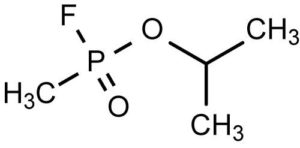As you’ve probably heard by now, sarin nerve agent was probably behind the death of more than 80 people in Syria last week. Bashar al-Assad is suspected of using the gas against civilians last week, in what is surely one of the most heinous acts of the ongoing Syrian Civil War. News media showed images of the victims struggling to breathe moving President Donald Trump to engage in a missle strike on Thursday night. The name sarin is an acronym of the four scientists who created it: Gerhard Schrader, Otto Ambros, Gerhard Ritter, and Hans-Jürgen von der Linde.
But what is sarin, and why is it so deadly?
Sarin is a clear colorless gas, that is also known as GB. In it’s purest form it has not taste and no odor. The organophosphorus compound is manufactured by humans, and not found in nature. It was first manufactured in the 1930s.
Sarin is deadly becuse it attacks the nervous system preventing proper degradation acetylcholine at neuromuscular junctions. The nerve gas binds to acetylcholinesterase, an enzyme that degrades the acetylcholine, to send signals between nerves and muscles. This means that when someone is exposed to sarin, even at very low levels, their nerve signals don’t communicate properly with muscles. The muscles do not contract or expand as they usually would. Death after sarin exposure will usually occur as a result suffocation due to the inability to control the muscles involved in breathing. Death usually occurs within 1 to 10 minutes after exposure.
Is there a cure?
There is an antidote for sarin exposure. Atropine treats the physiological symptoms of poisoning, but does not reverse the muscular symptoms. Biperiden is sometimes used as an alternative to atropine due to its better blood–brain barrier penetration and higher efficacy. The drug pralidoxime can regenerate cholinesterase activity, but only if administered within a 5 hour window.

